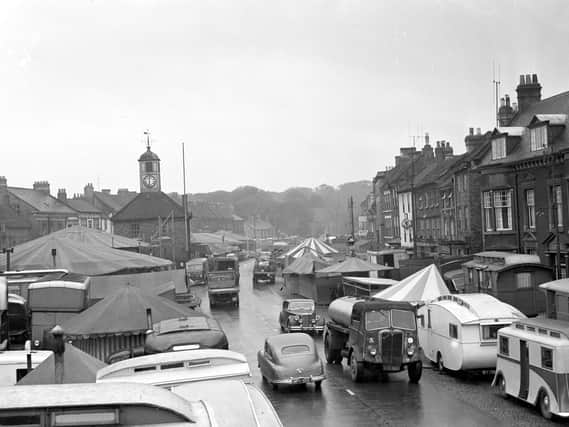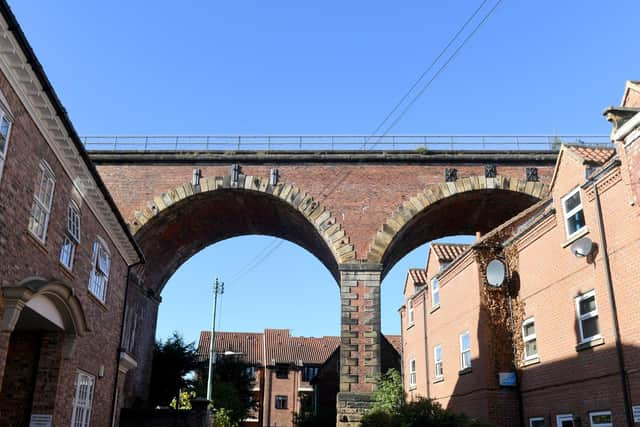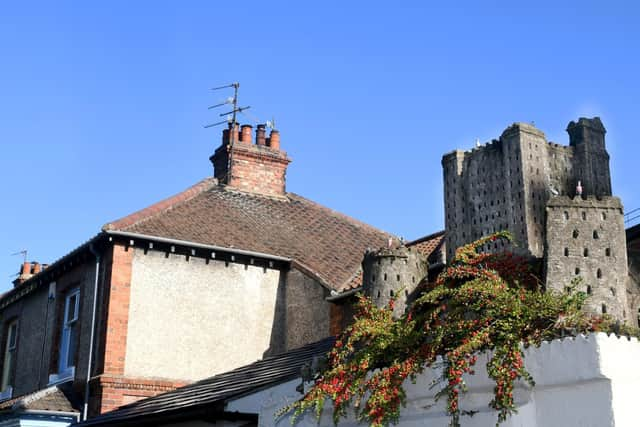Whether it's the railway, or tunnels and bridges - Yarm has quite a story to tell


Take Yarm Bridge as an example. It was built to the order of a remarkable man, Walter Skirlaw, who was born into pretty humble circumstances in around 1330. His home was in a hamlet called Swine, near Holderness, and the young Walter was educated by local clergymen, from whom he found his vocation and his direction in life.
He too wanted to join the church. But Walter rose higher than any mere monk. By 1359, he was already Archdeacon of the East Riding and only a few years later was given the Lord Privy Seal – making him a confidante of the King, in one of the great offices of state.
Advertisement
Hide AdAdvertisement
Hide AdHe contributed to the expense of building the central tower of York Minster (there is a fine medieval stained-glass window to his memory set in the stonework he had created) and to a refuge tower and chapter house in Howden, and the bridge at Yarm, which was opened in 1400, and which still stands.


In the mid-Georgian era, the people of Yarm thought they would do an upgrade to their bridge, using the most modern material that came to hand. Engineered entirely of iron, the first traffic to use it went across the Tees in 1805. But the last traffic came a year later, for it collapsed in the middle of the night.
The waters around Yarm have always shaped the community, since it sits on a small peninsula on the southern bank of the Tees, and over to the east it extends to the River Leven.
The name “Yarm” derives from an old English word meaning “a pool for catching fish” and it was large enough by 1086 to get a mention by the scribes creating the Domesday Book.
Advertisement
Hide AdAdvertisement
Hide AdIt must have been a place that was highly vulnerable to raids by Vikings, who – by the 10th century – had stopped their random marauding, and had started to settle their families in the east of England.


Our Nordic ancestors would have made the most of the river access and the relative ease of berthing. And one of them was definitely rather careless with his property, for he left his helmet behind. It was discovered in the 1950s by a gang of workmen who were digging drainage ditches in Chapel Yard. The distinguished archeologist and expert conservator Chris Caple published research last year which dated the helmet to the 10th century. You can see it in Preston Park Museum. It’s made of iron, with several bands and plates, all riveted together, with protection for the eyes and nose.
A couple of centuries after the helmet was lost (or hidden), a party of monks of the Dominican Order arrived in Yarm and set up a friary and a hospital – they remained until they were driven out by Henry VIII’s Dissolution of the Monasteries.
The site is now part of Yarm School, which can trace its roots back to 1590, when it first opened as a Free Grammar School, providing education for “disadvantaged boys”. Back then, there would probably be about two or three dozen lads at most who were taught the basics of language and how to write. Today, there are over 1,100 pupils.
Advertisement
Hide AdAdvertisement
Hide AdFor a relatively small town, Yarm has an interesting history when it comes to pubs and inns, such as the George and Dragon and the Tom Brown. The former has a claim to fame in that it was here that a public meeting held in 1821 found many locals gathered to press parliament to allow a bill to build the Stockton and Darlington Railway. After much pressure, they were successful.
And the latter pub is also part of Yarm’s rich heritage, for Tom Brown was a shoemaker’s apprentice before joining the army. He fought at the Battle of Dettingen (in 1743, and the last time that a British monarch ever led his men into battle).
George II was so impressed that he knighted him on the battlefield, gave him a pension of £30 a year and a gold-topped walking stick.
Tom returned home as the “valiant dragoon”, opened a pub and died in 1746, aged only 40. He is buried in the churchyard of Yarm’s parish church, St Mary Magdalene, and his grave is marked by a Portland stone replica of a Commonwealth War Graves headstone, set up in 1968 by his regimental descendants, the Queen’s Own Hussars.
Advertisement
Hide AdAdvertisement
Hide AdIn the flurry of “railwaymania” that occupied much of the Victorian era, Yarm was at the epicentre of innovation and invention. The rail line featured some remarkable pieces of engineering, none better than the viaduct on the approach to Yarm station. This structure is made of no less than seven million bricks, is well over 2,200 feet long and has 43 arches. Designed by the pioneering architect and engineer Thomas Grainger, building work started in 1849 and went on until 1851.
Yarm townsfolk, and visitors, love the beautiful High Street, where many buildings in the mellowed Georgian style still survive, and the gem in this diadem is the Grade II-listed Town Hall, which started life as a tollbooth to collect dues from travellers on the north-south coaching route. Today’s structure dates from 1710, with a nod to Dutch architecture.
It has a clocktower, belfry and a weather vane (the bell was repurposed from the older tollbooth and bears the inscription “Si Deus pro Nobis quis contra nos”, which translates as “If God is with us, who is against us”) and over the years it has served a multitude of purposes – a market, magistrates court, council offices and a handy public loo.
It is also a remarkable monument to local history, since it has several plaques recording notable incidents – the lads who served in the Second Boer War, the First World War, and those who served on the first five-strong committee to push through the Stockton and Darlington Railway among them.
Advertisement
Hide AdAdvertisement
Hide AdAnd, if you yearn for some solitude, Yarm is only a short stroll to the Rookery, a lush area of woodland, most of which was planted out about 200 years ago. There are ash, lime and sycamore trees in abundance. There’s quite a lot underneath your feet as well, for the town sits on so many tunnels and underground access routes that have been carved out over the centuries.
There’s one, it is said, in which many stuffed animals in glass cases were placed in storage. Bricked up for safety during the Second World War, the collection has never been seen again. Some claim that subterranean passageways were carved out so that monks from the friary could escape from persecution. A more prosaic explanation is that they were smugglers’ tunnels, which allowed the import of contraband without the pesky interference of the revenue men.
The tunnels blend folklore, legend and theory. And they add just a pinch more spice to the rich mix that is Yarm.